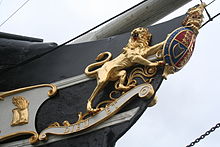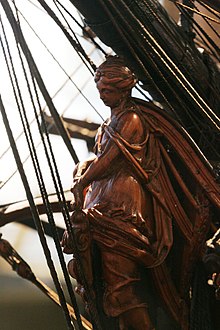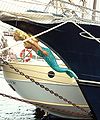figurehead


A figurehead is a figure usually carved out of wood, which is attached to ships, mainly sailing ships , under the bowsprit . The term derives from the Galion (Spanish for "balcony"), this was a porch in front of the stem of a galleon that supported the bowsprit. Initially, figures were placed on the galion by the Spaniards and Portuguese, and later they were attached to the outside. Although later types of ships no longer had a real galion , the name figurehead was retained. In the superstition of seafarers, the figure is supposed to watch the course of the ship and save it from misfortune.
An alternative to Galion's figures was and is the Krull - also Krullgalion or bow head - a spiral-shaped ornament similar to a violin snail .
history
The rock carvings at Leirfall in Stjørdal in North Trøndelag consist of around 1200 characters from the Norwegian Bronze Age (around 500 BC). The shape of the ships, which have originally designed stems , is remarkable . The steved tradition of the Vikings and the figurehead has its roots here.


The great age of figureheads began in the 17th century and lasted until the beginning of the 20th century. In the 18th century, the figurehead was called the ship's picture . At that time, the ships were often decorated with elaborate groups of figures. Initially only large ships, in the 19th century smaller ships were also equipped with a figure.
The figurehead is often designed in such a way that it is related to the ship's name. In part, she also served as the patron saint who influenced the success of a trip; their damage or even destruction was a bad omen and signaled great misfortune.
The shapes of the figureheads changed over time. Except the lions (on Dutch ships are always found lion as emblem of the country) were mermaids and nymphs preferred, but warriors, knights, princes, shipowners , merchants with cylinder and delicate and powerful female figures. In Italy , many ships of the Italian Navy have the Stella d'Italia , the Italian star, as a figurehead.
Representations of people can range from head to toe or, especially on some younger ships - if they still have figureheads at all - only show the head or a portrait from the waist up. The wealth of forms also became more discreet in depictions of animals. With the disappearance of the large trading sailors in favor of steel-built trading ships, the figurehead increasingly disappeared.
The Krullgalion or the bow head - a spiral-shaped ornament similar to a violin snail - had its wedding on US ships (English billethead or billet head ) from approx. 1830 to 1880. Existing examples of a Krullgalion can be found on the one built in England in 1887, now Amphitrite sailing under the German flag and the Statsraad Lehmkuhl, built in Germany in 1914 and sailing under the Norwegian flag .
Legends
Figureheads are often ascribed a mystical meaning: the figurehead of the British frigate Brunswick , who portrayed the Duke of Braunschweig in Scottish national costume, had his hat shot off on June 1, 1794. "It is not appropriate," said some seafarers, "for the noble lord to face his enemies bareheaded". As a replacement, the captain provided his gilded gala hat, whereupon the British fleet won against the French.
The American privateer General Armstrong carried a figurehead very similar to his portrait . When the ship had to be sunk near Faial in 1814 to avoid falling into the hands of the enemy, the crew insisted on saving the figure. Despite cannon fire, the figurehead was sawed off and brought to safety in a boat.
Once, when a sailing ship did not run as the captain wanted, he ordered a sailor to gently tickle the figurehead, a female figure, with the bobber and say: "Loop, min Deern, loop to!" After a few Moments a more favorable wind came up and the ship made a good trip.
The truth of such stories from Romantic Seafaring remains speculative. For the seafarers, the image of the galionspopp (doll) was the embodiment of the ship itself, the soul of the ship that carried it and to which they had confided.
Others
Extensive collections of figureheads can be viewed in the Altona Museum (Hamburg) and in the German Maritime Museum ( Bremerhaven ). The Bremerhaven Bugwelle fountain is decorated with a stylized female figurehead.
There are also the spellings " galleon figure" and " galleon figure", which are derived from the richly decorated sailing ship type galleon .
Symbolic word meaning
In a figurative sense, the term “figurehead” is used to designate specific people who are a “living figurehead” of an association or interest group or who hold a leadership or pioneering role. In the derogatory sense, one speaks of breakfast director .
See also
Picture gallery
Popular motif: mermaids ( Thalassa , Netherlands)
Representation of Abraham Duquesne , ca.1822 (French Naval Museum)
Implacable , ex Duguay-Trouin , probably 19th century ( National Maritime Museum )
Collectible: figure on jersey
Figurehead of Seute Deern , Bremerhaven
Figurehead of the Grand Duchess Elisabeth
Figurehead of the Cuauhtémoc
literature
- LG Carr Laughton: Old Ship Figure-Heads and Sterns . Dover Publications, 2001, ISBN 978-0-486-41533-8 (English).
- Giancarlo Costa: The wooden angels - figureheads from five centuries . Delius Klasing & Co., Bielefeld 1980, ISBN 3-7688-0330-9 .
- Margaret Baker: Folklore of the sea . David & Charles PLC, 1979, ISBN 978-0-7153-7568-6 (English).
- Hendrik Busmann: figurehead . In: RDK Labor, 2016.
Web links
- Definition of the figurehead with some examples
- www.galionsfiguren.de - Ship sculptors Birgit and Claus Hartmann
- Image of a bow head
Individual evidence
- ↑ Jean Randier: Nautical Antiques . Delius Klasing, Bielefeld 1976, ISBN 978-3-7688-0187-4 , page 184.
- ↑ Bettina Vaupel: How did the figurehead come about? In: Monuments , edition 3/2020, pp. 16 and 17.
- ↑ Billethead from Ship "Favorite". From the Tour: Woodcarving from the Index of American Design. Object 4 of 26 ( Memento of July 19, 2008 in the Internet Archive ) on the website of the National Gallery of Art , accessed on March 17, 2008 (English).
- ↑ Margaret Baker: Folklore of the sea . 1979, page 19.
- ^ Joseph C. Abdo: On the Edge of History . Tenth Island Editions, 2006, ISBN 978-972-99858-0-5 , page 74.







